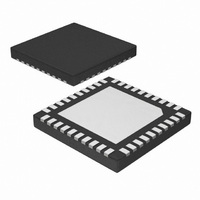ISL41334IRZ-T7A Intersil, ISL41334IRZ-T7A Datasheet - Page 16

ISL41334IRZ-T7A
Manufacturer Part Number
ISL41334IRZ-T7A
Description
IC TXRX RS232/485 DL 2PRT 40QFN
Manufacturer
Intersil
Datasheet
1.ISL81334IAZ-T.pdf
(28 pages)
Specifications of ISL41334IRZ-T7A
Lead Free Status / RoHS Status
Lead free / RoHS Compliant
Available stocks
Company
Part Number
Manufacturer
Quantity
Price
Company:
Part Number:
ISL41334IRZ-T7A
Manufacturer:
Intersil
Quantity:
74
SSOP) receiver outputs are not independently tri-statable.
ISL41334 (QFN) receiver outputs are tri-statable via an
active low RXEN input for each port (see “ISL41334 (QFN
Package) Special Features” on page 17 for more details).
TX FEATURES
The RS-485, RS-422 driver is a differential output device
that delivers at least 2.2V across a 54Ω load (RS-485), and
at least 2.5V across a 100Ω load (RS-422). Both levels
significantly exceed the standards requirements, and these
exceptional output voltages increase system noise immunity,
and/or allow for transmission over longer distances. The
drivers feature low propagation delay skew to maximize bit
widths, and to minimize EMI.
To allow multiple drivers on a bus, the RS-485 spec requires
that drivers survive worst case bus contentions undamaged.
The ISL81334, ISL41334 drivers meet this requirement via
driver output short circuit current limits, and on-chip thermal
shutdown circuitry. The output stages incorporate current
limiting circuitry that ensures that the output current never
exceeds the RS-485 specification, even at the common
mode voltage range extremes. In the event of a major short
circuit condition, devices also include a thermal shutdown
feature that disables the drivers whenever the die temperature
becomes excessive. This eliminates the power dissipation,
allowing the die to cool. The drivers automatically re-enable
after the die temperature drops about 15°. If the contention
persists, the thermal shutdown/re-enable cycle repeats until
the fault is cleared. Receivers stay operational during thermal
shutdown.
RS-485 multi-driver operation also requires drivers to include
tri-state functionality, so each port has a DE pin to control
this function. If the driver is used in an RS-422 network, such
that driver tri-state isn’t required, then the DE pin can be left
unconnected and an internal pull-up keeps it in the enabled
state. Drivers are also tri-stated when the IC is in SHDN, or
when the 5V power supply is off.
SPEED OPTIONS
The ISL81334 (SOIC, SSOP) has fixed, high slew rate driver
outputs optimized for 20Mbps data rates. The ISL41334
(QFN) offers three user selectable data rate options: “Fast”
for high slew rate and 20Mbps; “Medium” with slew rate
limiting set for 460kbps; “Slow” with even more slew rate
limiting for 115kbps operation. See “Data Rate, Cables, and
Terminations” on page 16 and “RS-485 Slew Rate Limited
Data Rates” on page 19 for more information.
Receiver performance is the same for all three speed
options.
DATA RATE, CABLES, AND TERMINATIONS
RS-485, RS-422 are intended for network lengths up to
4000’ (1220m), but the maximum system data rate
decreases as the transmission length increases. Devices
operating at the maximum data rate of 20Mbps are limited to
16
ISL81334, ISL41334
lengths of 20’ to 30’ (6m to 9m), while devices operating at or
below 115kbps can operate at the maximum length of 4000’
(1220m).
Higher data rates require faster edges, so both the
ISL81334, ISL41334 versions offer an edge rate capable of
20Mbps data rates. The ISL41334 also offers two slew rate
limited edge rates to minimize problems at slower data rates.
Nevertheless, for the best jitter performance when driving
long cables, the faster speed settings may be preferable,
even at low data rates. See “RS-485 Slew Rate Limited Data
Rates” on page 19 for details.
Twisted pair is the cable of choice for RS-485, RS-422
networks. Twisted pair cables tend to pick up noise and
other electromagnetically induced voltages as common
mode signals, which are effectively rejected by the
differential receivers in these ICs.
The preferred cable connection technique is “daisy-chaining”,
where the cable runs from the connector of one device directly
to the connector of the next device, such that cable stub
lengths are negligible. A “backbone” structure, where stubs
run from the main backbone cable to each device’s connector,
is the next best choice, but care must be taken to ensure that
each stub is electrically “short”. See Table 4 for recommended
maximum stub lengths for each speed option.
Proper termination is imperative to minimize reflections when
using the 20Mbps speed option. Short networks using the
medium and slow speed options need not be terminated, but
terminations are recommended unless power dissipation is an
overriding concern. Note that the RS-485 specification allows
a maximum of two terminations on a network, otherwise the
Tx output voltage may not meet the required V
In point-to-point, or point-to-multipoint (RS-422) networks,
the main cable should be terminated in its characteristic
impedance (typically 120Ω) at the end farthest from the
driver. In multi-receiver applications, stubs connecting
receivers to the main cable should be kept as short as
possible, but definitely shorter than the limits shown in
Table 4. Multipoint (RS-485) systems require that the main
cable be terminated in its characteristic impedance at both
ends. Again, keep stubs connecting a transceiver to the
main cable as short as possible, and refer to Table 4. Avoid
“star”, and other configurations, where there are many
“ends” which would require more than the two allowed
terminations to prevent reflections.
SPEED OPTION
TABLE 4. RECOMMENDED STUB LENGTHS
SLOW
FAST
MED
MAXIMUM STUB LENGTH
350 to 500 (107 to 152)
100 to 150 (30.5 to 46)
1 to 3 (0.3 to 0.9)
ft (m)
OD
November 21, 2007
.
FN6202.3













